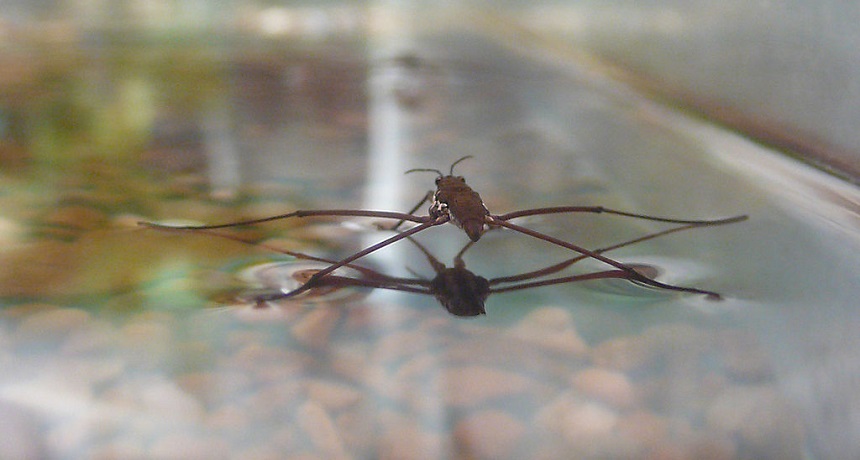Teen studies water strider disappearing act
ISEF finalist Xidian Zhang found out why water striders left his local ponds

These friendly water striders often inhabit rural ponds. So when they disappeared from the ponds around his house, high school student Xidian Zhang was determine to find out why.
TimVickers/Wikimedia Commons
LOS ANGELES – Last summer, Xidian Zhang, now 19, headed out to the local ponds near Puyang City in the Henan Province of China. The student at No. 1 Senior Middle School Puyang in Puyang City was looking for water striders, insects in the family Gerridae. The bugs used to spawn in the ponds near his home. In fact, he recalls playing with them throughout his early childhood. “But last year,” he says, “I couldn’t find any at all.”
Xidian was determined to find out why. And his results, which linked their disappearance to pollution, won the teen a trip to Los Angeles and a spot competing at the International Science and Engineering Fair. Run by Society for Science & the Public and sponsored by Intel, the 64th annual competition brought together students from all over the world, last month, to show off the results of their research. (SSP also publishes Science News for Students and this blog).
Water molecules tend to attract one another. Their attraction forms a film on the top of a body of water, creating what scientists call surface tension. Water striders have long legs, spread very wide. This allows the light, tiny bugs to glide atop the water.
But skating on water is a delicate balancing act. Chemicals such as soaps and detergents, for example, can decrease water’s surface tension. Without surface tension, water striders don’t have a strong liquid platform on which to stand. Quite simply: They can’t keep their heads above water.
Xidian hypothesized that pollutants in the local waters were disrupting the water’s surface tension. To find out, he surveyed the ponds around his town. Five of the seven ponds had no water striders. The teen noticed that those five ponds also were sites where people threw away their household wastes.
So the polluted ponds had no water striders. But that didn’t necessarily mean the pollution was responsible. To test that idea, the teen gathered healthy water striders and placed them in cups of water. Some of the water was clean and pure. Other cups had water with increasing levels of different pollutants, such as salt, vinegar, oil and detergents. All were chemicals contained in the household trash being dumped near the local pools.
It turns out that detergents in particular produced tough times for water striders. A concentration as tiny as six one hundred thousandths of a percent was enough to sink the delicate insects. China has water quality standards to ensure the local waters are clean. The water standards for detergents are half as high as the concentrations that killed the water striders.
With water striders vanishing from local ponds, Xidian now suspects that detergent levels in the ponds may be much higher than in his tests, a result of local pollution. The teen would like to see the pollution levels drop. And perhaps, he says, water striders could be recruited as a bioindicator —a species that points to the health of local waters. “The disappearance of water striders is a signal to us,” he says. “It’s a sign that we need to better protect our environment.”
Follow Eureka! Lab on Twitter
Power Words
bioindicator A species that can be used to measure the health of an ecosystem. Bioindicator species could be plants, animals, fungi or any other organism that is sensitive to pollution or other changes in their environment. The health or presence of the species can offer one sign of the health of the ecosystem in which it lives.
detergent A compound derived from petroleum products, often used for cleaning. Detergents work by breaking up and surrounding dirt particles or oily substances, so that they can be washed away with water.
surface tension The surface film of a liquid caused by the strong bonds between the molecules in the surface layer.
surfactant A chemical that decreases the attraction between water molecules. Manufacturers use such compounds to make it easier for water to spread on surfaces and to mix with other substances (such as oil).
water strider Any one of a group of insects in the family Gerridae. These insects have small bodies and long legs. They take advantage of surface tension to glide across the water’s surface.







